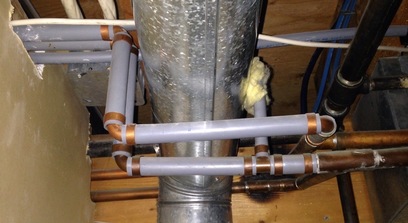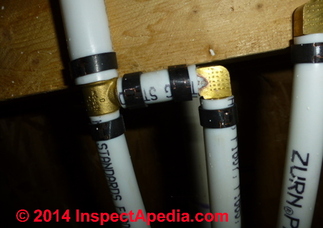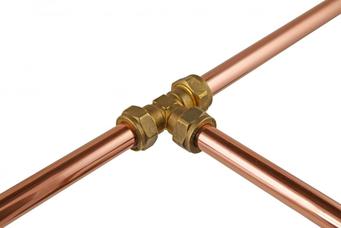POLY-B (Polybutylene) Water Supply Piping
Jul. 9, 2016What is it?
Poly-B was the first plastic piping material developed, intended to replace copper piping due to its affordability and ease of installation. It was installed in over 6 million homes in the U.S and 700,000 in Canada between 1978 and 1995. It is a grey piping material with stamped information along its length, and (in Canada) can be verified by its CSA Standard number "B137.8" or material designation "PB2110".
It was originally installed with grey plastic fittings and aluminum or copper crimp rings. This original installation method proved to be problematic, costing its manufacturer close to 1 Billion dollars in damages and replacement costs due to leakage - you can understand why insurance companies may get a bit nervous.
To fix the problem, the plastic fittings were replaced with copper or brass fittings and copper crimp rings, which is the method that was used in Poly-B installations here in Canada. As a result of the improved installation method, the majority of leakage issues reported in Canada have been from improper installation, rather than failure of the fittings themselves. For this reason, Poly-B with copper fittings is not usually an issue with insurance companies, but if you are buying a house with this piping material, you should definitely talk to your insurance company before sale closing to verify their specific policy. ***Some insurance companies in BC will require removal of Poly-B, regardless of installation method.***
(Copper/brass fittings)

What you need to know if you have Poly-B in your home...
1) The Poly-B resin is no longer manufactured and cannot be purchased. Plumbing code no longer recognizes Poly-B as an acceptable material, which means it cannot be used in new installations. For this reason, any repairs or partial upgrades of the piping material require a conversion kit to connection with PEX (Cross-Linked Polyethylene) or Copper piping - this will often incur extra cost for labour and material.
(PEX Piping) (Copper Piping)


2) Poly-B is susceptible to heat and should not be installed within 18 inches of a water heater - it should be connected to copper or metal braid lines that connect to the top of the water heater tank. Hot water temperature should also not be set higher than 130F. As a combustible plastic material, Poly-B must not be installed within 6 inches of a single-wall metal chimney ("vent connector" or "flue") serving a gas-fired appliance like a furnace or water heater, or within 9-12 inches of a metal chimney serving an oil-fired appliance. If installed too close, a simple solution is to install a proper heat shield between the plastic pipe and the vent connector.
3) Poly-B is susceptible to high water pressure - to avoid damage to the pipes resulting in rupture or leakage, water pressure should not be allowed to exceed 40-60psi. This can be tested with a 3/4" threaded water pressure gauge at the hose bib used for the washer machine. If you have Poly-B piping and your water pressure exceeds 60 psi, I recommend having a licensed plumber install a Pressure Reducing Valve ($60 value) that allows you to adjust the water pressure coming into the home, usually at the main shut-off valve. In areas where municipal water supply pressure is 80psi or more, pressure reducing valves are usually required by code. Excessive water pressure can ware down valves and pipes (regardless of materials used), damage appliances and void many appliance warranties.
4) Poly-B is permeable to oxygen and should never be used with a hydronic heating system (boiler), as it can cause premature corrosion and failure. Boilers are designed to re-circulate the same stagnant water over and over again as a means of transferring heat throughout the house, not oxygenated (fresh) water used for cooking, cleaning, etc. Water heaters (different than boilers) are designed with corrosion-resistant components to be able to move fresh water without premature corrosion of the tank itself.
5) As a plastic piping material, Poly-B should have support every 3 to 4 feet along its length to prevent leakage caused by excessive strain on connections.
6) Lastly, as with all large projects, if you plan to replace Poly-B piping with copper or PEX, I recommend obtaining estimates from 3 different contractors, as fees may vary significantly.
Written by:
DONOVAN ILLIG
Home Inspector & Residential Environmentalist
Premium Home Inspections Ltd.
250-617-3378 | donovan@premiumhi.net
CPBC License #71217



